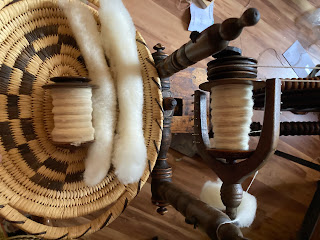It is no secret that I love bast fiber, spinning it and teaching about it. Something about the sturdy practicality of the resulting cloth appeals to me and I aspire to surrounding myself with handspun and handwoven linen and hemp household textiles and clothing. Every time I have woven with bast fiber I have sized the warp, per all advice i have been told or read and I have passed this on to students. I prefer, however, to speak from experience and so determined that I would attempt to weave a piece with handspun linen with no sizing, just to see what would happen and the pitfalls, problems, and frustrations that would occur.
I have been excited by the 'Berta's Flax' project originating in Austria and flowing across the world via the Facebook Group and ordered several kilos of fine pre 1950s line flax, grown and processed on farms in rural Austria and when I received them, of higher quality than I had been able to acquire before. To make room for this I spun up the line flax I had acquired prior to this, of varying quality and sources, experimenting with various ways of dressing my distaves. This led to a collection of yarn that was widely variable in quality and grist and I used this for my unsized experiment.

I created a 7 yard warp 20 inches wide sett at 30 epi and dressed my loom. I sett it more loosely than I normally would as I expected a lot of sticking from hairiness raised by the abrasion of weaving unsized yarn. I use a newcomb studio loom , which has a sectional beam dress the loom back to front, it has metal wire heddles (with a few flat steel ones as well) and a 12 dent reed. I wove plainweave. The first day of weaving went well, with one snapped warp and no trouble weaving, after about 12 inches of weaving.

As I continued to weave over the next few days I had 6 or 7 warp ends that consistently broke, and realized a skein I had set aside for weft as being indifferently spun had gotten into the pile I used for warp. I also had very large amounts of lint abrading off the warp accumulating behind the beater. This would occasionally form 'clots' around a group of warps and I needed to manually clear and separate them to get a clear shed. I did not have trouble with individual warp threads sticking to their neighbors apart from the clots of lint, which was a surprise to me. I expected them to stick.

Weaving was possible though not as pleasurable as i would like. I had to stop to mend a broken warp every foot or two, and had to be 'delicate' in the weaving and pay a great deal of attention to tension every time I advanced the warp. I advanced the warp about every two inches and kept the tension slightly looser than normal and was pleased that other weavers confirmed they too kept linen at a looser tension.
Once off the loom I mended some errors and then washed the fabric in hot water with detergent in my washing machine on the normal cycle and then put it though the standard cycle of the dryer on hot. A huge amount of lint came off in both processes and the resulting cloth was pleasantly rough but not stiff and has great drape. I ironed it on both sides, but did not press, mangle, or beetle the cloth.
Before wet finishing
After wet finishing
I am satisfied with the fabric which I will make into bath towels, it has a drape and hand very similar to commercial linen towels we had and which have worn out. I am looking forward to making them, which I will as soon as I weave some linen tape for hanging.
What I learned from this is that for a loosely sett handspun flax yarn I CAN weave unsized singles but I don't really want to. It is easier to use sized singles and I can justify taking the time to size my handspun bast yarns before using them as warp.




















